Current events involving politics, political office holders, political candidates, world events, local events, crime and other public affairs issues are discussed. Business news items as well as science and technology issues may appear.
Search This Blog
Wednesday, July 31, 2013
Building Swap Financed by USDA Supports Arts, Education Goals
FranklinPlanner
USDA Blog Post:
Posted by Kathy Beisner, Acting USDA Rural Development Delaware/Maryland State Director, on July 31, 2013 at 2:33 PM

During a tour of the new home of Sussex Academy (l-r) USDA Rural Development Community Program Director Denise MacLeish, USDA Director of Legislative and Public Affairs David Sandretti, rising freshman Cohen Davis, U.S. Senator Tom Carper, rising eight grader Elise Conlin, Acting Delaware/Maryland State Director Kathy Beisner, and Loan Specialist Angela Tilghman stand with Sussex Academy’s new logo. USDA Photo.
Sussex County, Delaware’s only charter school, the former Sussex Academy of Arts & Sciences middle school, is being re-named “Sussex Academy” as it expands to include a high school. But unlike most expansion projects, the academy is swapping its old building for an existing building that meets its needs, and it is doing it with help from USDA.
The swap was highlighted recently at an event attended by USDA Rural Development, school officials, and U.S. Senator Tom Carper.
The expansion of Sussex Academy was accelerated last fall when board members of Delmarva Christian High School (DCHS) approached the charter middle school with a novel idea – to exchange buildings. The two schools are located in Georgetown, Del., just a few miles apart. DCHS found its facility to be larger than currently needed. The building swap will allow Sussex Academy room, over time, to serve 780 students.
Financing for the project was made possible by USDA Rural Development’s Community Facilities Program, which provides both guaranteed and direct loans to public bodies and non-profit corporations for essential community facilities in rural areas of the country. Sussex Preparatory Academy Foundation, Inc. (SPAF) is a non-profit organization that supports the charter school. Located five miles apart, the 122,000-square-foot DCHS facility will be home to Sussex Academy while the Academy’s 38,000 square-foot building will be the new home for Delmarva Christian.
The moving transition is scheduled to be finalized this summer in time for the start of the 2013-14 year.
To find out more about how USDA Rural Development can assist your rural community click here.
Labels:
AMS,
APHIS,
ARRA,
conservation,
FAS,
FNS,
Forestry,
FS,
FSA,
FSIS,
KYF2,
NRCS,
rural development,
Tom Vilsack,
USDA
Providing Water for Cattle on the Navajo Nation
DiscountSchoolSupply.com - Save Up to 70% Off Retail Every Day! Click Here!
USDA Blog Post:
Posted by Barry Hamilton, NRCS Utah, Yahaira Lopez, NRCS NHQ, and Sarah Graddy, NRCS NHQ, on July 31, 2013 at 11:33 AM
Two chapters of the Navajo Nation in Utah are getting new livestock wells, thanks to USDA’s Natural Resources Conservation Service.
Members of the Teec Nos Pos and Red Mesa Chapters use wells drilled deep into the desert floor to water their 1,000 or so cattle. (A chapter is both a rural community and a unit of local government in the Navajo Nation.) But in the 2000s, the Navajo Nation Water Code Administration found, through testing, that these wells had high levels of arsenic, uranium and E. coli, rendering them non-potable for both humans and livestock.
After the discovery, ranchers had to truck in water from up to two hours away for their livestock because they could not afford to drill new wells. Despite their best efforts, because of the harsh desert conditions, some of the cattle died.
Over the past year, through USDA’s StrikeForce for Rural Growth and Opportunity initiative, NRCS was able to partner with the chapters and the Navajo Nation Department of Agriculture to dig two new wells and safely decommission the contaminated wells.
StrikeForce addresses high-priority funding and technical assistance needs in rural communities in 16 states, including Arizona, with a special emphasis on historically underserved communities and producers in counties with persistent poverty. NRCS was able to contribute 90 percent of the cost of digging the new wells and closing up the old wells.
The Navajo Nation, which is about 27,000 square miles—the size of West Virginia—has one of the highest poverty levels of any area in the United States. More than 173,000 people live on the reservation.
Now that the new wells have been drilled, NRCS is helping the Teec Nos Pos and Red Mesa Chapters install pipeline and troughs to provide multiple access points for cattle to drink from.
Because of the success of this project, Fred White, Executive Director of the Navajo Nation Division of Natural Resources, is now exploring more opportunities to enhance and protect the natural resources of Tribal lands with NRCS and other USDA agencies.
Follow NRCS on Twitter.
Check out other conservation-related stories on the USDA blog.

Cattle drink clean water from a new well on the Navajo Nation, dug with the help of NRCS.
Labels:
AMS,
APHIS,
ARRA,
conservation,
FAS,
FNS,
Forestry,
FS,
FSA,
FSIS,
NRCS,
rural development,
Tom Vilsack,
USDA
Polish Dissident Adam Michnik on Eastern Europe after Communism - SPIEGEL ONLINE
Adam Michnik is editor-in-chief of Poland's leading daily and its most prominent former dissident. In a SPIEGEL interview, he talks about the threat of authoritarian regimes in Eastern Europe, the decline of the region's political culture and feelings of being treated like second-class citizens in Europe.
Polish Dissident Adam Michnik on Eastern Europe after Communism - SPIEGEL ONLINE
Polish Dissident Adam Michnik on Eastern Europe after Communism - SPIEGEL ONLINE
Top 10 consumer complaints - Jul. 31, 2013
Shady auto dealers, shoddy construction work and incessant debt collectors were once again among the most common targets of consumer gripes last year.
Top 10 consumer complaints - Jul. 31, 2013
The Spicy Story of Green Chiles
ESET
USDA Blog Post:
Posted by Ed Avalos, Under Secretary for Marketing and Regulatory Programs, on July 31, 2013 at 10:33 AM

Hatch green chiles can be used in everything from potato salad to lemonade.
It’s no secret I love New Mexican grown green chiles. So does Melissa’s World Variety Produce in Los Angeles, California. So much so, that during a recent trip to California, I attended a spicy workshop and reception hosted by Melissa’s, featuring New Mexican Hatch green chiles.
“When I grew up, I thought there was only one kind of chile: we just called them green.” says corporate chef Rodriguez who grew up in El Paso, Texas.
Southwesterners like Ida and I may just call them “greens”. However, the rest of the country is quickly getting to know these meaty, flavorful Hatch green chiles, named after Hatch, New Mexico, epicenter of state’s chile growing region.
The event was a Hatch chile lover’s dream: green chile salsa, guacamole, and deviled eggs made with green chile. Green chile cornbread, shrimp and club sandwiches. There were green chile cookies and green chile ice cubes in my lemonade and ginger ale. I felt like I was home.
But why were the green chiles I know and love from New Mexico being celebrated in California?
USDA’s Specialty Crop Block Grant Program (SCBG) certainly played a role. This program, authorized by the 2008 Farm Bill and administered by USDA’s Agricultural Marketing Service (AMS), promotes fruits and vegetables and other specialty crops nationwide. State Departments of Agriculture apply to the USDA for block grants to expand markets for the unique specialty crops of their state.
New Mexico received SCBG funding to support educational workshops, events, marketing, and promotions featuring green chiles. As the biggest producer of chiles in the country, this crop provides over 2,000 full time and over 10,000 part time jobs to New Mexico. However, between 1992-2011, New Mexico’s production acres for green chiles dropped from 34,500 to 9,500. The green chile needed some help.
That’s what brought me to Melissa’s chile extravaganza. The event at Melissa’s was part of the SCBG effort to strengthen New Mexico’s green chile industry and expand the market for this important crop. With each new green chile lover in California and elsewhere, a New Mexican green chile farmer benefits.
The Specialty Crop Block Grant is due for reauthorization. The Food, Farms and Jobs Act would do that. However, the bill is currently awaiting Congressional approval. Secretary Vilsack recently outlined 10 reasons why Congress needs to pass the Food, Farm and Jobs Act. Supporting our nation’s specialty crops is another.
Theologian: Pope Francis Comments Are Bad for Catholic Gays - SPIEGEL ONLINE
Pope Francis has sparked enthusiasm with his call for greater tolerance toward gays. But it's too soon to celebrate, says theologian David Berger. The pope's warning not to engage in gay propaganda puts him on par with homophobes like Russian President Vladimir Putin, he contends.
Theologian: Pope Francis Comments Are Bad for Catholic Gays - SPIEGEL ONLINE
Theologian: Pope Francis Comments Are Bad for Catholic Gays - SPIEGEL ONLINE
Doubt Grows in Reforms of Rajoy Government in Spain - SPIEGEL ONLINE
Measures to pull Spain out of the crisis are failing to bear fruit and exacerbating social tensions. While some are optimistic, the core problems remain, and many are questioning the old elite's ability to clean up the financial sector and reform the country.
Doubt Grows in Reforms of Rajoy Government in Spain - SPIEGEL ONLINE
Doubt Grows in Reforms of Rajoy Government in Spain - SPIEGEL ONLINE
Tomb Raiders in Egypt Exploit Political Chaos to Steal Antiquities - SPIEGEL ONLINE
Egypt's cultural heritage is in danger. Grave robbers, sometimes heavily armed, are taking advantage of political chaos to plunder its poorly guarded archaeological sites. Authorities feel powerless to stop them and fear that ancient treasures might be lost forever.
Tomb Raiders in Egypt Exploit Political Chaos to Steal Antiquities - SPIEGEL ONLINE
Tomb Raiders in Egypt Exploit Political Chaos to Steal Antiquities - SPIEGEL ONLINE
NSU Neo Nazi Terror Trial Advances Despite Complexity - SPIEGEL ONLINE
The NSU trial in Munich has so far been plodding along with disjointed hearings on multiple crimes and defendants, but the presiding judge has nevertheless moved the trial forward. Yet another complication is emerging, though, between prosecutors and victims.
NSU Neo Nazi Terror Trial Advances Despite Complexity - SPIEGEL ONLINE
NSU Neo Nazi Terror Trial Advances Despite Complexity - SPIEGEL ONLINE
US Military Court Convicts Bradley Manning in WikiLeaks Case - SPIEGEL ONLINE
A US military court acquitted Bradley Manning of the worst charge against him, but he isn't out of the woods yet.
US Military Court Convicts Bradley Manning in WikiLeaks Case - SPIEGEL ONLINE
US Military Court Convicts Bradley Manning in WikiLeaks Case - SPIEGEL ONLINE
Berkeley Lab Researchers Discover Universal Law for Light Absorption in 2D Semiconductors
JULY 31, 2013
News Release
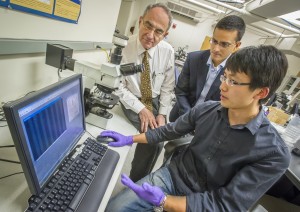
(From left) Eli Yablonovitch, Ali Javey and Hui Fang discovered a simple law of light absorption for 2D semiconductors that should open doors to exotic new optoelectronic and photonic technologies. (Photo by Roy Kaltschmidt)
Working with ultrathin membranes of the semiconductor indium arsenide, a team of researchers with the U.S. Department of Energy (DOE)’s Lawrence Berkeley National Laboratory (Berkeley Lab) has discovered a quantum unit of photon absorption, which they have dubbed “AQ,” that should be general to all 2D semiconductors, including compound semiconductors of the III-V family that are favored for solar films and optoelectronic devices. This discovery not only provides new insight into the optical properties of 2D semiconductors and quantum wells, it should also open doors to exotic new optoelectronic and photonic technologies.
“We used free-standing indium arsenide membranes down to three nanometers in thickness as a model material system to accurately probe the absorption properties of 2D semiconductors as a function of membrane thickness and electron band structure,” says Ali Javey, a faculty scientist in Berkeley Lab’s Materials Sciences Division and a professor of electrical engineering and computer science at the University of California (UC) Berkeley. “We discovered that the magnitude of step-wise absorptance in these materials is independent of thickness and band structure details.”
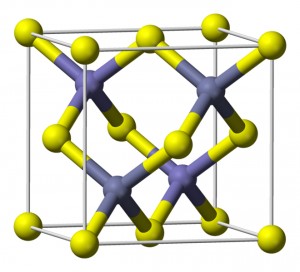
Indium arsenide is a III–V semiconductor with electron mobility and velocity that make it an outstanding candidate for future high-speed, low-power opto-electronic devices.
Previous work has shown that graphene, a two-dimensional sheet of carbon, has a universal value of light absorption. Javey, Yablonovitch and their colleagues have now found that a similar generalized law applies to all 2D semiconductors. This discovery was made possible by a unique process that Javey and his research group developed in which thin films of indium arsenide are transferred onto an optically transparent substrate, in this case calcium fluoride.
“This provided us with ultrathin membranes of indium arsenide, only a few unit cells in thickness, that absorb light on a substrate that absorbed no light,” Javey says. “We were then able to investigate the optical absorption properties of membranes that ranged in thickness from three to 19 nanometers as a function of band structure and thickness.”
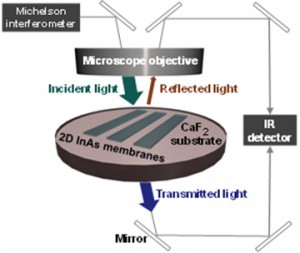
In this FTIR microspectroscopy study, light absorption spectra are obtained from measured transmission and reflection spectra in which the incident light angle is perpendicular to the membrane.
“This absorption law appears to be universal for all 2D semiconductor systems,” says Yablonovitch. “Our results add to the basic understanding of electron–photon interactions under strong quantum confinement and provide a unique insight toward the use of 2D semiconductors for novel photonic and optoelectronic applications.”
This research was supported by DOE’s Office of Science and the National Science Foundation.
# # #
Lawrence Berkeley National Laboratory addresses the world’s most urgent scientific challenges by advancing sustainable energy, protecting human health, creating new materials, and revealing the origin and fate of the universe. Founded in 1931, Berkeley Lab’s scientific expertise has been recognized with 13 Nobel prizes. The University of California manages Berkeley Lab for the U.S. Department of Energy’s Office of Science. For more, visit www.lbl.gov.The DOE Office of Science is the single largest supporter of basic research in the physical sciences in the United States and is working to address some of the most pressing challenges of our time. For more information, please visit science.energy.gov.
The Advanced Light Source is a third-generation synchrotron light source producing light in the x-ray region of the spectrum that is a billion times brighter than the sun. A DOE national user facility, the ALS attracts scientists from around the world and supports its users in doing outstanding science in a safe environment. For more information visit www-als.lbl.gov/.The Advanced Light Source is a third-generation synchrotron light source producing light in the x-ray region of the spectrum that is a billion times brighter than the sun. A DOE national user facility, the ALS attracts scientists from around the world and supports its users in doing outstanding science in a safe environment. For more information visit http://www.als.lbl.gov/.
Tuesday, July 30, 2013
FEMA Corps Assists Disaster Survivors in Little Axe, Okla. ID: 67433)
FEMA participates in preparedness workshops at Home Depot (ID: 67399)
FEMA participates in preparedness workshops at Home Depot (ID: 67401)
DiscountSchoolSupply.com - Save Up to 70% Off Retail Every Day! Click Here!
FEMA participates in preparedness workshops at Home Depot (ID: 67403)
FCO Swearing In (ID: 67424)
DiscountSchoolSupply.com - Save Up to 70% Off Retail Every Day! Click Here!
Roofers make repairs in Moore, Okla. (ID: 67406)
Keeping NASS Ahead of the Technology Curve
USDA Blog Post:
Posted by Pam Hird, National Agricultural Statistics Service, on July 30, 2013 at 1:05 PM

Pam Hird, National Agricultural Statistics Service. Photo courtesy of FedTech Magazine
This post is part of the Science Today feature series on the USDA blog. Check back each week as we showcase stories and news from USDA’s rich science and research portfolio.
2013 is the International Year of Statistics. As part of this global event, every month this year USDA’s National Agricultural Statistics Service will profile careers of individuals who are making significant contributions to improve agricultural statistics in the United States.
Unlike the math and agricultural statisticians with whom I work daily, I took a completely different career path into the world of agricultural statistics. In college, I started out as an accounting major at Shepherd University, Shepherdstown, WV. Based on the recommendation of friends, I took some courses in computer programming and the love affair began when I was introduced to Fortran and Cobol. After college, I stuck to my IT knowledge and went into sales revolving around IT solutions for government contractors and customers including Dulles Airport, Martin Marietta, and Contel. These experiences taught me to think logically, to put myself in the other person’s shoes, and to communicate effectively.
Eventually my IT path took me to the National Agricultural Statistics Service (NASS) and I joined the agency’s Information Technology Division. While new to the world of statistics, I was inspired by the agency’s commitment to keep improving its processes to ensure highest levels of data accuracy and security. One of my first programming experiences was a summary program for the poultry slaughter system.
I was not in NASS headquarters very long before moving to Colorado to provide IT and program support to field offices in the newly-formed section called Field Services. At Field Services, I worked with our International Programs Office on the Nicaragua project to develop and support the agency intranet.
All of these experiences prepared me for the role that I accepted close to four years ago. Each year, NASS interviews tens of thousands of farmers face-to-face for its agricultural surveys. And so the Computer Assisted Personal Interviewing (CAPI) project, focused on making the personal interviewing process more efficient and secure, was born. As project manager, the team and I developed a creative and innovative solution using iPads as a data collection tool, making NASS the first federal agency to successfully implement this technology.
The CAPI solution saves NASS both time and money. The use of iPads for face-to-face interviewing allowed NASS to greatly cut back on printing, mailing and administrative functions for the survey program. Data entry is not required since the forms are filled out electronically and multiple surveys for a respondent are coordinated electronically. The additional bonus was that the new system was more secure than ever, enhancing safety of an individual’s responses.
Best of all, the solution gave me a chance to directly impact and further enhance NASS’ statistical programs. Of course, as is always the case with anything involving technology, the challenges and rewards keep on coming. But I look forward to what tomorrow brings and the continuing role of this remarkable program in producing accurate agricultural statistics.
German Prosecutors File Tax Evasion Charges Against Uli Hoeness - SPIEGEL ONLINE
German prosecutors have filed tax evasion charges against Bayern Munich President Uli Hoeness, one of the most prominent figures in German football, after he reported himself to authorities earlier this year over a previously undeclared Swiss bank account.
German Prosecutors File Tax Evasion Charges Against Uli Hoeness - SPIEGEL ONLINE
German Prosecutors File Tax Evasion Charges Against Uli Hoeness - SPIEGEL ONLINE
Making California and Minnesota a Magnet for New Jobs
DiscountSchoolSupply.com - Save Up to 70% Off Retail Every Day! Click Here!
USDA Blog Post:
Posted by Nikki Gillespie and Sarah Marquart, Minnesota and California USDA Public Affairs Specialists, on July 30, 2013 at 12:10 PM
While many manufacturing companies provide well-paying jobs and play a vital role in creating vibrant, healthy rural communities, sometimes rural communities may struggle to attract these companies. To help bridge this gap, the Investing in Manufacturing Communities Partnership (IMCP) was created. This Administration-wide effort brings together federal departments and agencies to provide coordinated assistance to communities to become more attractive for manufacturers.
Recently, USDA hosted two IMCP events in Minnesota and California with diverse audiences of about 120 stakeholders representing manufacturing businesses, lenders, economic development organizations, universities and community colleges, small businesses development centers, and local leaders among others. At both meetings, USDA Rural Business-Cooperative Service Administrator Lillian Salerno led panels of federal partners that discussed the initiative and sought input on the needs of local manufacturers.
“I am here to see how USDA can help strengthen the manufacturing sector to create sustainable jobs,” Salerno said. “In his State of the Union Address, President Obama said his number-one priority is ‘making America a magnet for new jobs and manufacturing,’ and these discussions are a great way to leverage local, state, federal and private-sector assistance.”
Both events highlighted the importance of regional strategies with local examples, as well as the essential roles universities, technical and community colleges play in the future of manufacturing.
In Minnesota, the Southern Minnesota Regional Competitiveness Project was featured as a great example of regional collaboration. The Competitiveness Project brings together many regional partners to design an economic development strategy focused on the key assets in southern Minnesota’s 38 counties. And in California, Innovate North State, a public-private partnership focuses on helping innovative growth companies succeed, was highlighted for their regional work.
A panel discussion was held in North Mankato, Minn. at South Central College. Participants heard from Senator Amy Klobuchar, South Central College President Keith Stover and Minnesota State University Vice President Bob Hoffman, CEO of Southwest Minnesota Initiative Foundation Tim Penny, and AgStar Senior Vice President for Investments in Rural Affairs John Monson, in addition to the federal panel. Senator Klobuchar highlighted the current manufacturing climate in Minnesota, which represents 13 percent of all jobs in the state. She emphasized the need to ensure businesses and government can work together to build resources that keep the economy strong and competitive.
Meanwhile, in Woodland, Calif., Federal partners held a roundtable at the Heidrick Ag History Museum. Joining the federal panel was Governor’s Office of Business and Economic Development (GO-Biz) Director Kish Rajan. As a part of the event, a panel of local stakeholders highlighted the building blocks necessary to support manufacturing: technology, goods movements, capital and finance, workforce, local government and bio-economy and provided several recommendations to the federal panel.
Through the Commerce Department’s Economic Development Administration (EDA) the IMCP initiative will provide 25 communities with $200,000 awards for implementation strategies later this year, and next year will assist five to six communities for awards up to $25 million each for specific projects necessary to attract investment. USDA will support the initiative through the Rural Business Opportunity Grant (RBOG) program.
To learn more about IMCP grants click here. To read more about President Obama’s economic proposals click here.
Egypt and Gaza: Closed Smuggling Sinai Tunnels Could Ruin Hamas - SPIEGEL ONLINE
The smuggling tunnels in Sinai are essential for the economy of the Gaza Strip. But since the unrest broke out in Egypt, they have been closed off -- plunging the ruling Hamas party into financial crisis.
Egypt and Gaza: Closed Smuggling Sinai Tunnels Could Ruin Hamas - SPIEGEL ONLINE
Egypt and Gaza: Closed Smuggling Sinai Tunnels Could Ruin Hamas - SPIEGEL ONLINE
Voter List Manipulations Mar Election As Zimbabwe Goes to Polls - SPIEGEL ONLINE
Even before this week's vote in Zimbabwe, it seems clear that President Robert Mugabe will remain in power. Voter lists have been manipulated, critics are being intimidated and the opposition is divided.
Voter List Manipulations Mar Election As Zimbabwe Goes to Polls - SPIEGEL ONLINE
Voter List Manipulations Mar Election As Zimbabwe Goes to Polls - SPIEGEL ONLINE
Berlusconi Tax Fraud Verdict Could Endanger Government in Italy - SPIEGEL ONLINE
For the first time, Silvio Berlusconi is threatened with a legally binding conviction. Italy's highest court is due to rule this week on the former premier's tax fraud verdict. It could finally mean an end to the magnate's political career -- and spell serious trouble for the fragile governing coalition.
Berlusconi Tax Fraud Verdict Could Endanger Government in Italy - SPIEGEL ONLINE
Berlusconi Tax Fraud Verdict Could Endanger Government in Italy - SPIEGEL ONLINE
Aid Groups Warn of Afghan Security Vacuum - SPIEGEL ONLINE
The looming end of NATO operations in Afghanistan is creating a security vacuum that puts the entire purpose of the international mission at risk. Aid groups may have to scale down their operations, and Berlin is alarmed at US threats of total withdrawal.
Aid Groups Warn of Afghan Security Vacuum - SPIEGEL ONLINE
Aid Groups Warn of Afghan Security Vacuum - SPIEGEL ONLINE
Human Rights Groups Praise Pope Francis for New Stance on Gay Priests - SPIEGEL ONLINE
In a departure from the Vatican's traditional view of gays, Pope Francis told reporters on Monday that he doesn't judge priests for their sexual orientation. His words have been welcomed by human rights groups, but critics say he still avoided the issue of sin.
Human Rights Groups Praise Pope Francis for New Stance on Gay Priests - SPIEGEL ONLINE
Human Rights Groups Praise Pope Francis for New Stance on Gay Priests - SPIEGEL ONLINE
Monday, July 29, 2013
Defense Attorney for Beate Zschäpe Leaves Law Firm - SPIEGEL ONLINE
German attorney Anja Sturm is one of three defense lawyers representing Beate Zschäpe, a suspected member of a murderous neo-Nazi terror cell. She says she has faced hostility from colleagues for taking the case and is now leaving the Berlin firm where she works.
Defense Attorney for Beate Zschäpe Leaves Law Firm - SPIEGEL ONLINE
Defense Attorney for Beate Zschäpe Leaves Law Firm - SPIEGEL ONLINE
Tax reform secrecy plan blasted - Jul. 29, 2013
A Senate committee's decision to keep tax reform proposals secret for 50 years has drawn strong objections and calls for transparency from a diverse array of tax, business and advocacy groups.
Tax reform secrecy plan blasted - Jul. 29, 2013
Egypt Struggles With Political Chaos After Second Revolution - SPIEGEL ONLINE
Amid renewed turbulence, Egyptian politics are at a critical turning point. With opposing movements at loggerheads over the country's next government, much is at stake for future generations, the Middle East and even the rest of the world.
Egypt Struggles With Political Chaos After Second Revolution - SPIEGEL ONLINE
Egypt Struggles With Political Chaos After Second Revolution - SPIEGEL ONLINE
Bernanke to be grilled in Greenberg suit - Jul. 29, 2013
Ben Bernanke will have to answer questions from the lawyers of former AIG CEO Maurice "Hank" Greenberg, a federal judge ruled Monday.
Bernanke to be grilled in Greenberg suit - Jul. 29, 2013
German Government Responds to NSA Spying and Data Collection Leaks - SPIEGEL ONLINE
Weeks after the NSA scandal, the German government is slowly breaking its silence on the issue. In the midst of the election campaign, Chancellery head Ronald Pofalla has been tasked with defusing the affair. So far, he hasn't answered the most pressing questions.
German Government Responds to NSA Spying and Data Collection Leaks - SPIEGEL ONLINE
German Government Responds to NSA Spying and Data Collection Leaks - SPIEGEL ONLINE
Greek Opposition Leader in Dispute With German Newspaper - SPIEGEL ONLINE
After being asked this weekend about previous anti-German comments, Greek leftist opposition leader Alexis Tsipras cut short an interview with one of the country's top newspapers, the Frankfurter Allgemeine Zeitung. Within minutes, he threw out the reporter for allegedly unethical reporting, a charge the paper denies.
Greek Opposition Leader in Dispute With German Newspaper - SPIEGEL ONLINE
Greek Opposition Leader in Dispute With German Newspaper - SPIEGEL ONLINE
Labor Violations Rife At Apple Manufacturing Partners in China - SPIEGEL ONLINE
Apple might have abandoned manufacturing supplier Foxconn in the wake of a scandal over deplorable working conditions in its Chinese factories, but it seems that labor rights violations are also rife at Pegatron, its new partner.
Labor Violations Rife At Apple Manufacturing Partners in China - SPIEGEL ONLINE
Labor Violations Rife At Apple Manufacturing Partners in China - SPIEGEL ONLINE
A Makeover for a House Loaded with Memories
USDA Blog Post:
Posted by Tammi Schone, South Dakota Public Affairs Specialist, USDA Rural Development, on July 29, 2013 at 11:15 AM
Nellie Buckman is the daughter of a migrant worker. Growing up her family moved from place to place a lot. She never really had a place to call home until her adult years when she moved into a little tiny house that was originally from Igloo, South Dakota, which incidentally is located on the same lot line as her current residence which was built by the U.S. Department of Housing and Urban Development(HUD) in 1979. Over the years, the Buckmans raised 10 children in this home. The transition from the little small house to the HUD house was quite an experience for the family. The HUD house was much bigger and in the beginning, the children all slept in one bedroom until they got used to having extra space. Her children now grown, Buckman’s home continues to be a gathering place for her large family.
“I love having a place to call home, to care for, and have all of my trinkets and memories surround me,” said Nellie Buckman.
Throughout the years the house has seen its share of wear and tear – weather beaten from snow, rain, wind, and hail. The outside structure was in desperate need of repair. USDA Rural Development partnered with Oglala Sioux Tribe Partnership for Housing in getting the application put together, Neighborhood Housing Services of the Black Hills provided additional funds to complete the renovations to the home, and Loafer Construction of Kyle, SD was the contractor for the project.
“No more leaks in the roof, the house is now quite a bit warmer in the winter and cooler in the summer, ” stated an excited Buckman. When USDA Rural Development Housing Specialist Ruth O’Neill arrived at the home for a final inspection she stated, “I drove right by it…the house with a new metal roof and pretty pink siding. The trees were cleaned up and everything looked so nice. It looked like a new home!” When asked for advice to others that are looking to fix up their home, Nellie stated, “Don’t worry about the past, look toward the future. USDA will work you through your issues whatever they may be, they will help you fill out your application or share ideas on how to work with your credit. I thank them for keeping my house a home.”
In South Dakota, Rural Development programs helped 1,409 families to obtain homes or preserve homeownership through making essential repairs that helped them to remain in their homes last year.
Ready-to-sign license speeds up Sandia tech transfer
Sandia Labs News Releases
July 29, 2013
Ready-to-sign license speeds up Sandia tech transfer
Share This Page
Share on facebookShare on twitterShare on linkedinShare on pinterest_shareMore Sharing Services0
ALBUQUERQUE, N.M. — Sandia National Laboratories is building a portfolio of intellectual property (IP) that can be licensed by businesses in as little as an hour.
“This is the simplest process possible,” said Sandia business development specialist Bob Westervelt, who helped create the ready-to-sign licensing program that businesses can access on the Sandia website. “The language is clear and easy to understand. We can say, ‘Here’s the license, here are the terms. Once you and Sandia have signed it, you can start using the intellectual property.’”

Business development specialist Bob Westervelt is on the Sandia National Laboratories team that created the ready-to-sign licensing program for intellectual property. (Photo courtesy of Sandia National Laboratories) Click on the thumbnail for a high-resolution image.
Sandia’s goal is to get more of the national labs’ innovations into the hands of small businesses and entrepreneurs. Sandia has about 1,300 patents available for licensing. Westervelt said the licensing group, which works with companies of all sizes, noticed that smaller businesses often are daunted by the number of patents to search through and the complex licensing process.
Recently, the group came up with the idea of creating a standard license for certain IP it identifies as being desirable. “We look through the IP for technologies we’re surprised aren’t being used, that need more visibility and that still have a lot of time left on the patent,” Westervelt said.
Small businesses can lack the time or manpower to sift through 1,300 patents to see whether Sandia has something that might help them be more successful. “If we give them a shorter list and simplify the process, they’re more likely to notice good opportunities,” Westervelt said.
The ready-to-sign license is uncomplicated, with simplified language and pared-down terms, conditions and reporting requirements. And it costs less. “We are offering relatively small up-front fees, in the $3,000 range, and low-percentage royalties,” Westervelt said. “We don’t want to impose a financial burden on a small business that needs cash flow.”
So far eight patents qualify for the program, from a drive system for industrial applications that require high torque and low rpm to a compact spectrometer that can detect trace amounts of gases such as carbon monoxide and methane to a vehicle barrier that holds up to a powerful impact. More ready-to-sign licenses are in the pipeline, and Westervelt said the group hopes to assemble a portfolio of about 50.
“We want a manageable number that can have the most impact,” he said. “These are all technologies that no one has licensed in areas where small businesses might be able to get a foothold. A small company could take any of these licenses and run with it.”
The licenses are nonexclusive, so any number of companies can make use of a technology. “It’s not first-come first-served for the IP,” Westervelt said. “If five companies are interested in a technology, all five can license it.”
One has been signed so far. Advance Plumbing of Albuquerque licensed the Labs’ Hedgehog water-purification technology. Company President Vincent Sanchez said he signed on because of the simplicity of the licensing process.

The Hedgehog is a submersible recirculation pump with an attached filter. The water-purification technology is in Sandia National Laboratories’ ready-to-sign licensing program. (Photo courtesy of Sandia National Laboratories) Click on the thumbnail for a high-resolution image.
“This was really easy to get into,” he said. “I would not have looked at it if finding the technology and doing the agreement was a big process requiring certification and lots of financials and other reporting. I’m not in a position to do all that. If it’s easy, I can say, ‘Why not? Let’s take a look.’”
Pete Atherton, senior manager of Industry Partnerships at Sandia, said Sandia is always looking for better ways to transfer technology for the public good. “The ready-to-sign program is a new component of our initiative to make licensing Sandia’s technology easier and faster,” he said.
Ready-to-sign licenses are listed here, with options to click on a technology for information and download a PDF file with the paperwork. “You click on one link and it downloads everything you need,” Westervelt said.
Visit this website for more information on licensing and technology transfer at Sandia Labs.
Sandia National Laboratories is a multi-program laboratory operated by Sandia Corporation, a wholly owned subsidiary of Lockheed Martin company, for the U.S. Department of Energy’s National Nuclear Security Administration. With main facilities in Albuquerque, N.M., and Livermore, Calif., Sandia has major R&D responsibilities in national security, energy and environmental technologies and economic competitiveness.
U.S. Army National Guard Takes Advantage of CDP Training for Their Region (ID: 67390)
U.S. Army National Guard Takes Advantage of CDP Training for Their Region (ID: 67392)
Home Depot Hurricane Preparedness Clinic (ID: 67397)
Home Depot Hurricane Preparedness Clinic (ID: 67394)
Home Depot Hurricane Preparedness Clinic (ID: 67395)
Get $200 of Windows Azure free with your 1-Month TrialQuickly build, deploy & manage apps using any OS, language, or tool.>Get it now
Tetrapod Quantum Dots Light the Way to Stronger Polymers
Berkeley Lab Researchers Use Fluorescent Tetrapod Quantum Dots to Measure the Mechanical Strength of Polymer Fibers
JULY 29, 2013
Feature
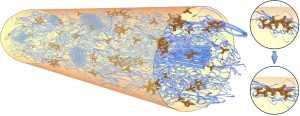
Fluorescent tetrapod quantum dots or tQDs (brown) serve as stress probes that allow precise measurement of polymer fiber tensile strength with minimal impact on mechanical properties. Inserts show relaxed tQDs (upper) and stressed tQDs (lower).
In a study led by Paul Alivisatos, Berkeley Lab director and the Larry and Diane Bock Professor of Nanotechnology at the University of California (UC) Berkeley, the research team incorporated into polymer fibers a population of tetrapod quantum dots (tQDs) consisting of a cadmium-selenide (CdSe) core and four cadmium sulfide (CdS) arms. The tQDs were incorporated into the polymer fibers via electrospinning, among today’s leading techniques for processing polymers, in which a large electric field is applied to droplets of polymer solution to create micro- and nano-sized fibers. This is the first known application of electrospinning to tQDs.
“The electrospinning process allowed us to put an enormous amount of tQDs, up to 20-percent by weight, into the fibers with minimal effects on the polymer’s bulk mechanical properties,” Alivisatos says. “The tQDs are capable of fluorescently monitoring not only simple uniaxial stress, but stress relaxation and behavior under cyclic varying loads. Furthermore, the tQDs are elastic and recoverable, and undergo no permanent change in sensing ability even upon many cycles of loading to failure.”
Alivisatos is the corresponding author of a paper describing this research in the journalNANO Letters titled “Tetrapod Nanocrystals as Fluorescent Stress Probes of Electrospun Nanocomposites.” Coauthors were Shilpa Raja, Andrew Olson, Kari Thorkelsson, Andrew Luong, Lillian Hsueh, Guoqing Chang, Bernd Gludovatz, Liwei Lin, Ting Xu and Robert Ritchie.
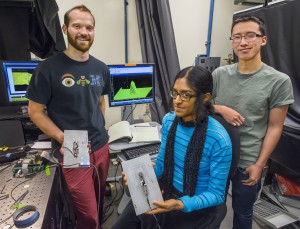
From left, Andrew Olson, Shilpa Raja and Andrew Luong are members of Paul Alivisatos's research group who used electrospinning to incorporate tetrapod quantum dot stress probes into polymer fibers. (Photo by Roy Kaltschmidt)
“Understanding the interface between the polymer and the nanofiller and how stresses are transferred across that barrier are critical in reproducibly synthesizing composites,” Alivisatos says. “All of the established techniques for providing this information have drawbacks, including altering the molecular-level composition and structure of the polymer and potentially weakening mechanical properties such as toughness. It has therefore been of considerable interest to develop optical luminescent stress-sensing nanoparticles and find a way to embed them inside polymer fibers with minimal impact on the mechanical properties that are being sensed.”
The Berkeley Lab researchers met this challenge by combining semiconductor tQDs of CdSe/CdS, which were developed in an earlier study by Alivisatos and his research group, with electrospinning. The CdSe/CdS tQDs are exceptionally well-suited as nanoscale stress sensors because an applied stress will bend the arms of the tetrapods, causing a shift in the color of their fluorescence. The large electric field used in electrospinning results in a uniform dispersal of tQD aggregates throughout the polymer matrix, thereby minimizing the formation of stress concentrations that would act to degrade the mechanical properties of the polymer. Electrospinning also provided a much stronger bond between the polymer fibers and the tQDs than a previous diffusion-based technique for using tQDs as stress probes that was reported two years ago by Alivisatos and his group. Much higher concentrations of tQDs could also be a achieved with electrospinning rather than diffusion.
When stress was applied to the polymer nanocomposites, elastic and plastic regions of deformation were easily observed as a shift in the fluorescence of the tQDs even at low particle concentrations. As particle concentrations were increased, a greater fluorescence shift per unit strain was observed. The tQDs acted as non-perturbing probes that tests proved were not adversely affecting the mechanical properties of the polymer fibers in any significant way.
“We performed mechanical tests using a traditional tensile testing machine with all of our types of polymer fibers,” says Shilpa Raja, a lead author of the Nano Letters paper along with Andrew Olson, both members of Alivisatos’ research group. “While the tQDs undoubtedly change the composition of the fiber – it is no longer pure polylactic acid but instead a composite – we found that the mechanical properties of the composite and crystallinity of the polymer phase show minimal change.”
The research team believes their tQD probes should prove valuable for a variety of biological, imaging and materials engineering applications.
“A big advantage in the development of new polymer nanocomposites would be to use tQDs to monitor stress build-ups prior to material failure to see how the material was failing before it actually broke apart,” says co-lead author Olson. “The tQDs could also help in the development of new smart materials by providing insight into why a composite either never exhibited a desired nanoparticle property or stopped exhibiting it during deformation from normal usage.”
For biological applications, the tQD is responsive to forces on the nanoNewton scale, which is the amount of force exerted by living cells as they move around within the body. A prime example of this is metastasizing cancer cells that move through the surrounding extracellular matrix. Other cells that exert force include the fibroblasts that help repair wounds, and cardiomyocytes, the muscle cells in the heart that beat.
“All of these types of cells are known to exert nanoNewton forces, but it is very difficult to measure them,” Raja says.
“We’ve done preliminary studies in which we have shown that cardiomyocytes on top of a layer of tQDs can be induced to beat and the tQD layer will show fluorescent shifts in places where the cells are beating. This could be extended to a more biologically-relevant environment in order to study the effects of chemicals and drugs on the metastasis of cancer cells.”
Another exciting potential application is the use of tQDs to make smart polymer nanocomposites that can sense when they have cracks or are about to fracture and can strengthen themselves in response.
“With our technique we are combining two fields that are usually separate and have never been combined on the nanoscale, optical sensing and polymer nanocomposite mechanical tunability,” Raja says. “As the tetrapods are incredibly strong, orders of magnitude stronger than typical polymers, ultimately they can make for stronger interfaces that can self-report impending fracture.”
This research was primarily supported by the DOE Office of Science.
# # #
DOE’s Office of Science is the single largest supporter of basic research in the physical sciences in the United States, and is working to address some of the most pressing challenges of our time. For more information, please visit the Office of Science website atscience.energy.gov/.
Additional Information
For more about the research of Paul Alivisatos go here
Subscribe to:
Posts (Atom)










